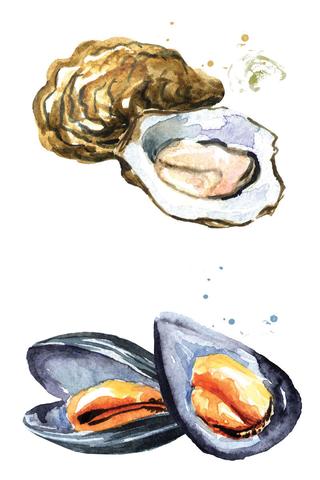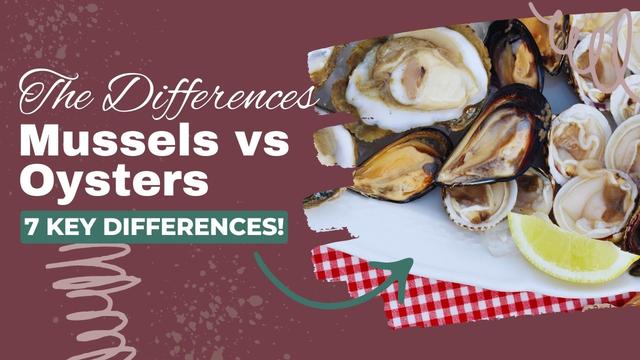
“Mussels vs Oysters: Unveiling the Battle of the Bivalves! Discover the contrasting flavors, textures, and nutritional benefits of these two beloved shellfish. Dive into our comprehensive analysis to determine which delicacy reigns supreme in taste and versatility. Get ready to tantalize your taste buds with this ultimate showdown!”
Mussels Vs Oysters
Mussels and oysters are both part of the mollusk family, but they have several key differences. The biggest difference is that mussels can be found in both saltwater and freshwater, while oysters can only be found in saltwater. Mussels also have a smoother shell compared to the more calcified and strange-shaped shell of oysters. Due to their availability, mussels are generally cheaper than oysters.

Another difference between mussels and oysters is in how they are consumed. Oysters can be eaten raw, while mussels should be cooked before consumption. Mussels can be found in both freshwater and marine environments, with different species preferring different habitats. On the other hand, oysters are only found in salty or brackish waters along the coast and cluster together on rocks or other hard surfaces.
The taste and texture of mussels and oysters also differ. Mussels have a slightly salty, chewy texture with a mild “fishy” flavor and a sweet undertone. Oysters, on the other hand, are generally considered tastier and often described as buttery, jelly-like, and sweet. Both mollusks can form pearls but it is rare for mussels and valuable for certain species of oysters.
Location
Mussels can be found in both saltwater and freshwater environments. In freshwater, they are typically found in the sand and gravel bottoms of rivers and streams that have good quality, flowing water. Marine mussels are more diverse in their habitat preferences, with some species preferring quiet bays or lagoons, while others thrive in the pounding waves of the coastline.
Oysters, on the other hand, can only be found in saltwater environments along the coast. They cluster together on rocks, piers, or any hard surface under the water. Oysters require a hard surface to attach themselves to so that they don’t get buried under sand or gravel and die. Once they find their forever home, they often fuse together and can be mistaken for rocks or reefs.
Appearance
Mussels have a smooth shell that is often dark blue or black on the outside, with a silver or gray color on the inside. They are usually asymmetrical and can be a bit rough to the touch. Oysters, on the other hand, have highly calcified shells that are lighter in color, ranging from white to gray to brown. The shape of oysters is often strange and irregular.
Nutrition
Mussels and oysters are both nutritious seafood options. Mussels are rich in protein and lower in calories and carbs compared to oysters. They are also a good source of vitamins and minerals. Oysters, on the other hand, are high in zinc, iron, Vitamin A, and Vitamin B. They are known for their aphrodisiac properties due to their rich amino acids content.
Mussels can be cooked in various ways such as smoking, boiling, steaming, roasting, or frying. They have a mild “fishy” flavor with a salty and slightly sweet undertone. It is important to consume live mussels and discard any broken or open shells to avoid food poisoning. On the other hand, oysters can be eaten raw but should be thoroughly washed before consumption. They have a delicate texture that is often described as buttery, jelly-like, and sweet.
Mussels are generally cheaper than oysters due to their availability. They can be bought in bulk and freeze well for longer shelf life. However, if not frozen, mussels only have a shelf life of 1-2 days. Oysters have a refrigerated shelf life of up to 4 weeks but their taste declines over time. Both mollusks are best when consumed fresh for optimal flavor and quality.
Taste

Mussels have a fairly mild “fishy” flavor with a salty undertone. They are chewy and slightly sweet, making them a versatile addition to many dishes.
Oysters are known for their delicious taste and are often considered the tastier of the two mollusks. They have a buttery, jelly-like texture and a sweet flavor. Oysters are typically more tender than mussels once cooked, further enhancing their enjoyable taste.
Conclusion

In conclusion, the biggest difference between mussels and oysters lies in their habitat and shell characteristics. Mussels can be found in both saltwater and freshwater environments, while oysters are strictly limited to salty, brackish waters along the coast. Mussels have smoother shells compared to the highly calcified and often irregularly shaped shells of oysters. Additionally, mussels are generally more affordable due to their availability in comparison to oysters.
Another significant distinction is their culinary preparation. While oysters can be enjoyed raw, mussels should only be consumed after heat treatment to ensure safety. Oysters are known for being a delicacy with a buttery, jelly-like texture and sweet flavor, while mussels have a mild “fishy” taste with a salty and slightly sweet undertone.
Overall, both mollusks offer unique flavors and textures that appeal to seafood enthusiasts. However, it is important to handle and cook them properly to avoid food poisoning. Whether you prefer the tender elegance of oysters or the chewy satisfaction of mussels, these shellfish provide a delightful culinary experience when prepared correctly.
In the debate between mussels and oysters, both shellfish offer unique flavors and nutritional benefits. While mussels are more affordable and versatile in cooking, oysters boast a delicate taste and are often associated with luxury dining. Ultimately, personal preference plays a key role in determining which one is the winner on your plate.
Learn More About Grilling
If you want to learn more about grilling, check out these other helpful resources!









